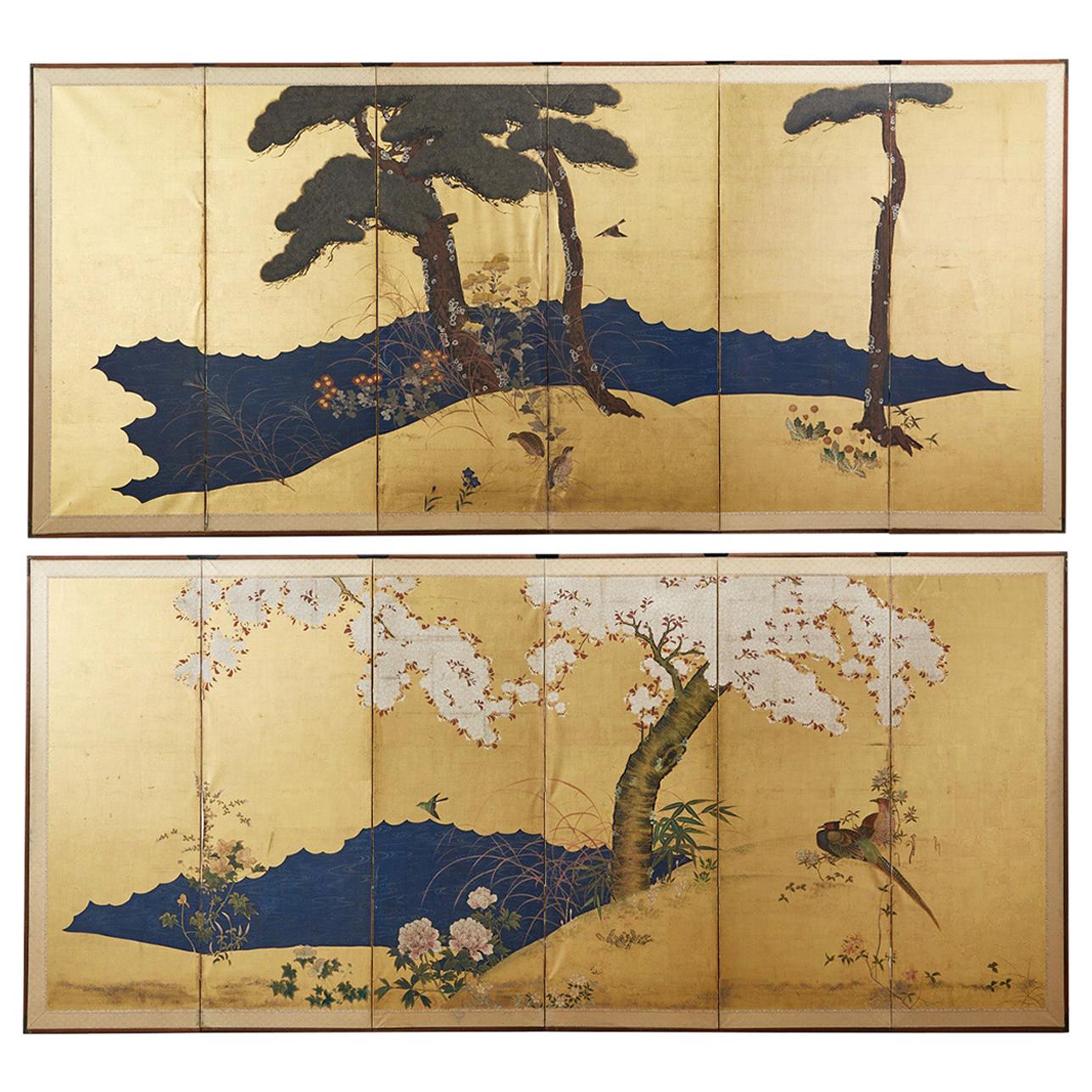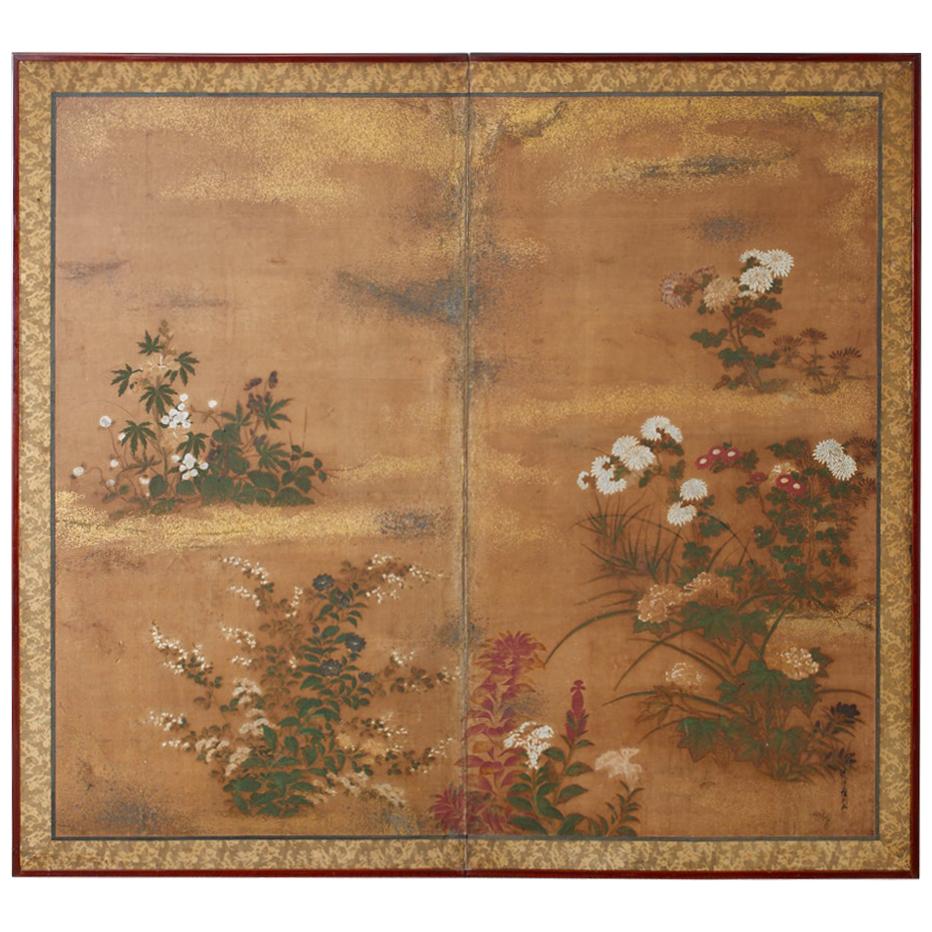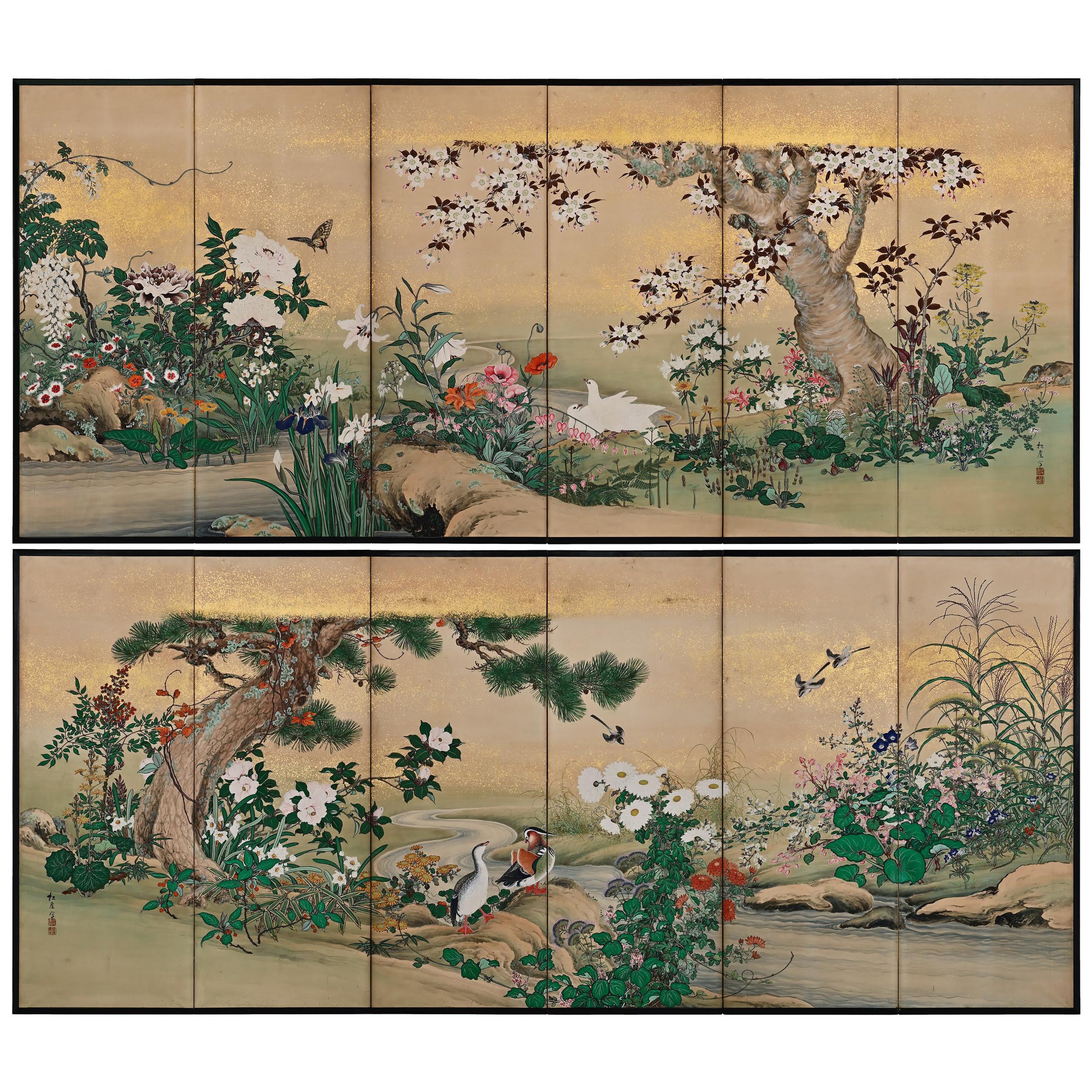Items Similar to Meiji Era, Circa 1900 Japanese Screen Pair, Flowers & Birds of Spring & Autumn
Want more images or videos?
Request additional images or videos from the seller
1 of 12
Meiji Era, Circa 1900 Japanese Screen Pair, Flowers & Birds of Spring & Autumn
About the Item
Flowers & Birds of Spring and Autumn
Unknown artist.
Japan. Meiji period, circa 1900.
A pair of six-fold screens. Ink, color, gofun and gold leaf on paper.
Signed: Gaga Sha
Top Seal: Minamoto Shoji In
Bottom Seal: Meiryu
Dimensions:
Each screen H. 68” x W. 148” (173cm x 376cm)
A pair of six-fold Japanese flower and bird screens from the late Meiji period. The cherry blossom tree on the right screen paired with sparrows represents spring, and on the left screen, the maple tree with its turning leaves and the flock of Japanese tits symbolizes autumn. Painted at the turn of the 20th century the artist was clearly caught up in the wave of modernization which stimulated young Japanese painters at the time. Rather than the modest coloring of the then dominant Maruyama/Shijo schools of painting the artist used saturated colors to create a vivid and dramatic effect. Similarly the daring composition has moved away from the typically lyrical qualities found in earlier compositions. Here, the artist depicts a scene of life at the top of the trees, a realm where humans are rarely able to enter. The ancient trees are contrasted strongly against the youthful exuberance of the birds and their song, color and excitement resonate across the screens. The fleeting beauty of the cherry blossoms and autumn foliage illustrates all too perfectly that nothing in this world is permanent, everything passes away at some point. A sad but beautiful admiration for this impermanence has been an important part of the Japanese mindset since ancient times. In Japanese, it's called "mono no aware." Another highlight of this expansive bird-and-flower painting is the artist’s ability to capture movement. Like a piece of animation, with each bird, we can imagine the series of moments before and after the painted scene.
- Dimensions:Height: 68 in (172.72 cm)Width: 148 in (375.92 cm)Depth: 0.75 in (1.91 cm)
- Sold As:Set of 2
- Style:Meiji (Of the Period)
- Materials and Techniques:
- Place of Origin:
- Period:
- Date of Manufacture:circa 1900
- Condition:Wear consistent with age and use. The screens are in good, original condition.
- Seller Location:Kyoto, JP
- Reference Number:1stDibs: LU2472325540322
About the Seller
5.0
Recognized Seller
These prestigious sellers are industry leaders and represent the highest echelon for item quality and design.
Gold Seller
These expertly vetted sellers are highly rated and consistently exceed customer expectations.
Established in 2001
1stDibs seller since 2016
60 sales on 1stDibs
Typical response time: 6 hours
- ShippingRetrieving quote...Ships From: Kyoto, Japan
- Return PolicyA return for this item may be initiated within 10 days of delivery.
More From This SellerView All
- Meiji Period Japanese Screen Pair, One Hundred Birds by Hasegawa GyokujunLocated in Kyoto, JPOne hundred birds Hasegawa Gyokujun (1863-1921) Meiji period, circa 1900. Ink, color and gofun on silk. Dimensions of each screen: H. 170 cm x W. 190 cm (67’’ x 75”) Despite the title, well over 100 birds are represented in this pair of two-fold Japanese screens (the title functions figuratively to convey the idea of a large number). The monumental work is rendered with a comprehensive and highly complex composition which is exquisitely executed and meticulously colored. More a celebration of naturalism than the traditional “One Hundred Birds” paintings which originated in China. This was a subject matter known for its auspicious meaning as much as its actual depiction of nature. These paintings generally had a phoenix (occasionally peacocks) placed in the center, and the other birds paying homage to it. In this quintessentially Japanese scene painted by Gyokujun, a couple of long-tailed birds modeled after paradise flycatchers are included; these are traditional auspicious motifs in Oriental bird and flower painting and denote themes such as celebration and enduring generations. In addition there is the playful inclusion of single exotic parrot. Even so, the vast majority of the birds and flowers are native to Japan. Reading the scene from right to left, from spring through to autumn, the overwhelming sense is one of movement and haste. It is almost as if the birds are in a race, with the fleetest leading the way forward. Although these native birds were commonly drawn amongst artists of the Shijo school, rarely were they painted with such drama and dynamism. It is not strictly a depiction of sketched birds whose manner was faithfully handed down through the traditions of the Shijo school. Rather we see Gyokujun seeking and achieving new expressions in the heart of the turbulent Meiji period. Hasegawa Gyokujun (1863-1921) was born in Kyoto. He was the eldest son of Hasegawa Gyokuho, a Shijo school painter who studied under Matsumura Keibun. Gyokujun studied painting under his father and became a prominent member of the Kyoto painti ng world from a young age. In 1891 he established the ‘Young Painters Social Club’ along with Takeuchi Seiho, Miyake Gogyo and Taniguchi Kokyo. Also in 1891 he was selected as a judge of the Great Private Paintings Exhibition along with Takeuchi Seiho, Yamamoto Shunkyo...Category
Antique Early 1900s Japanese Meiji Paintings and Screens
MaterialsSilk, Wood
- 19th Century Japanese Screen Pair. Flowers & Birds of the Four SeasonsLocated in Kyoto, JPFlowers & Birds of the Four Seasons Pair of six-fold Japanese Screens. Ink, color, gofun and gold on paper. Second half of the 19th Centur...Category
Antique Late 19th Century Japanese Meiji Paintings and Screens
MaterialsWood, Paper
- Japanese Silver Screen Pair, Meiji Period, Herons & Plovers, Shijo SchoolLocated in Kyoto, JPHeron & Plovers Ink and silver leaf on paper Maekawa Bunrei (1837-1917) A pair of low six-panel Japanese screens by Maekawa Bunrei, a later master of the Kyoto based Shijo school of painting. On the right screen a solitary white heron stands motionless in a stream. On the left screen plovers play along a shoreline. The elegant forms are executed employing fluid, minimalistic ink brushstrokes. The soft brushstrokes and the sharp light of the silver leaf lend the scenes a sense of translucence. The sophisticated composition superbly exploits the long, horizontal pictorial surface of the pair of folding screens...Category
Antique Early 1900s Japanese Meiji Paintings and Screens
MaterialsSilver Leaf
- Japanese Screen Painting, Early 19th Century, Autumn Flowers by Sakai HoitsuLocated in Kyoto, JPA two-fold Japanese screen by the Rimpa school artist Sakai Hoitsu (1761-1828), Japan, 19th century, Edo period. This small Japanese folding screen pai...Category
Antique Early 19th Century Japanese Edo Paintings and Screens
MaterialsWood, Silk
- Circa 1900 Japanese Screen. Cherry Blossoms in Moonlight. Meiji period.Located in Kyoto, JPKobayashi Shosen (1877-1946) Cherry Blossoms in Moonlight Six-panel Japanese Screen. Ink, color and gofun on paper. The image depicts a stunning scene captured on a six-panel Japa...Category
Antique 1890s Japanese Meiji Paintings and Screens
MaterialsPaper
- Japanese Screen Painting, Cat & Pumpkin Patch. Showa Era, 1940sLocated in Kyoto, JPChuichi Konno (1915-2006) Cat and Pumpkin Patch Showa period, 1940s. Folding screen in two-panels. Painted on paper with mineral pigments and gofun. Sign: Chuichi Sea...Category
Vintage 1940s Japanese Showa Paintings and Screens
MaterialsPaper, Wood
You May Also Like
- Japanese Meiji Two Panel Screen Song Birds in SakuraLocated in Rio Vista, CAExceptional Japanese Meiji period two-panel screen, circa 1900. Featuring songbirds amid sakura cherry trees and flowering peony. Made in the Nihonga School style on handcrafted mulb...Category
20th Century Japanese Meiji Paintings and Screens
MaterialsBrass
- Meiji Era Japanese Two Panel Hand Painted Wood Table Screen Tale of GenjiLocated in Studio City, CAA Meiji era Japanese two-panel wood screen, with illustrated images from The Tale of Genji that are exquisitely painted directly on wood with fine detail and precision, accented with scattered 24k gold leaf specks in cloud forms, rendered in the manner of Heian period...Category
Antique 19th Century Japanese Meiji Paintings and Screens
MaterialsGold Leaf
- Pair of Japanese Meiji Six Panel Screens of Seasonal LandscapesLocated in Rio Vista, CAFascinating pair of large Japanese Meiji period six-panel screens of seasonal landscapes with flowers and birds. The first screen depicts a pair of pheasants in a spring landscape with a white flowering cherry tree, peonies, and rose of Sharon with brush clover. The second screen depicts a pair of quail in an autumn landscape with flowering autumn plants and grasses including chrysanthemums, bellflowers, and ominaeshi. The umbrella pines appear to be in the manner of Kano Tanyu...Category
Antique 19th Century Japanese Meiji Paintings and Screens
MaterialsBrass, Gold Leaf
- Japanese Edo Two-Panel Screen Flowers of AutumnLocated in Rio Vista, CAImpressive early 19th century Japanese Edo period two-panel screen featuring flowering plants and grasses of autumn. Painted in the Tosa School style Bunka Bunsei period or Ogosho pe...Category
Antique 19th Century Japanese Edo Paintings and Screens
MaterialsSilk, Wood, Paper
- Japanese Two-Panel Screen Spring FlowersLocated in Hudson, NYA vibrant celebration of spring using a colorful ensemble of coxcomb, irises, lilies, hybiscus, and a blossoming cherry tree. Great examples of "tarashikomi" or "painting-in", a Rim...Category
Vintage 1930s Japanese Showa Paintings and Screens
MaterialsSilk, Paper
- Japanese Meiji Riverside Scroll Painting, c. 1900Located in Chicago, ILAlthough western painting was initially embraced during Japan’s Meiji period (1868-1912), artists brought on a revival of traditional painting styles as they sought to create a modern Japanese style with roots in the past. This exquisite hanging scroll demonstrates the preference for soft layering of gray tones with judicious use of color. The landscape is rendered in soft ink washes that subtly distinguish between water, mountain, and sky. The scroll painting...Category
Early 20th Century Japanese Meiji Paintings and Screens
MaterialsPaper
Recently Viewed
View AllMore Ways To Browse
Japan Flower
Japanese Flower
Circa Screen
Antique Furniture Springs
Birds Japan
Flower Paintings
Gold Japanese Flowers
Birds Pair Gold
Six Fold
Flower Maple
Flower Seal
Japanese Bird Painting
No Early Birds
Painting Pair Flowers
Pair Of Flower Paintings
Hand Painted Japanese Screen
Gold Leaf Art Pair
Japanese Screen Ink





